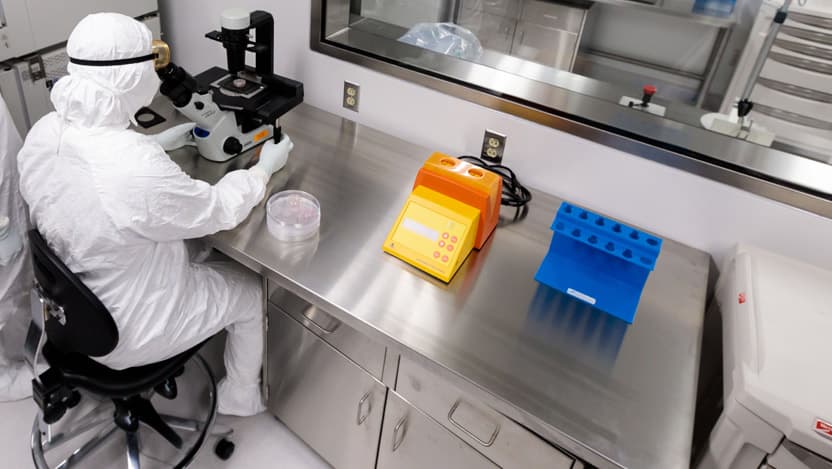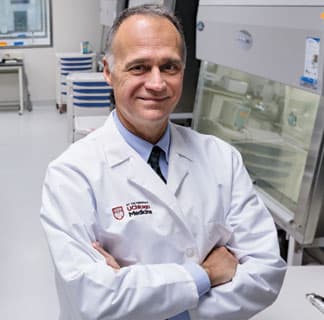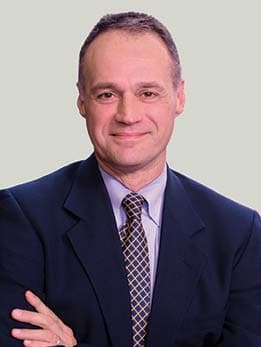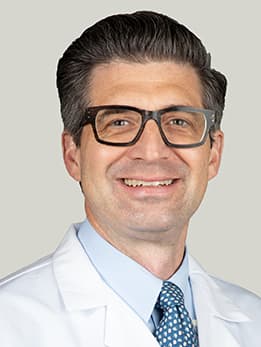Stem cell transplant team looks inward to improve survival rates for patients

When a car stops running, the cause usually turns out to be a broken part that needs to be replaced. Similarly, in the bone marrow of patients with blood diseases, the stem cells responsible for creating blood cells are not working as they should. Through a procedure known as stem cell transplant, sometimes referred to as bone marrow transplant, the sick patient’s diseased bone marrow and immune system can be replaced with healthy stem cells from a donor.
Today, the procedure is used for many cancers and blood diseases once considered incurable. For some types of blood diseases, a stem cell transplant is the standard of care; for others, it’s only considered if other treatments have been unsuccessful.
Although thousands of people who have cancer and other diseases have been cured with stem cell transplantation, there are risks associated with the treatment, and complications are common. The most serious concerns are the disease coming back, or relapsing, and another complication is where the new transplanted immune system attacks the normal cells of the patient, known as graft-versus-host disease.
UChicago Medicine had the best one-year stem cell transplant outcomes in Chicago and the highest relative to their predicted outcomes.
Patients must be followed closely after the transplant to address these complications as they arise. Clinicians and data analysts meticulously document complications following transplant and patient long-term survival. This data informs clinicians on how best to treat patients over time and can be an indication of how individual programs are doing.
The data is also collected by the Center for International Bone and Marrow Transplant Research (CIBMTR), an organization dedicated to improving survival, treatment and quality of life for transplant patients. Every year, the group issues a report with the outcomes data from all 172 transplant programs across the United States, including UChicago Medicine.
This information can help patients, families, referring providers and insurance companies identify the transplant centers that are the best at treating blood cancers like leukemia, myelodysplastic syndromes, myelofibrosis, myeloma and lymphoma. It also gives transplant centers a way to assess the quality and effectiveness of their programs year-over-year.
UChicago Medicine's most current outcomes data reflects the results of work initiated by the hematopoietic stem cell transplantation team several years ago.
In 2015, newly arrived stem cell transplant and cellular therapy expert Michael Bishop, MD, Professor of Medicine, viewed the CIBMTR rankings as a tremendous opportunity to establish UChicago Medicine as one of the premier stem cell transplant programs both nationally and internationally.
Things were off to a great start because of UChicago Medicine’s strengths in research. UChicago Medicine offers patients access to more innovative clinical trials than any other hospital in the region. Its physicians are internationally recognized experts in their fields. UChicago Medicine is also home to the David and Etta Jonas Center for Cellular Therapy, where scientists work on making the next breakthroughs in cellular therapy, especially CAR T-cell therapy, an emerging form of cancer treatment.
Bishop, as Director of the Hematopoietic Stem Cell Transplantation Program, rallied his team and together they began a journey to deliver “the absolute best clinical care.”
A strategy for success
Sharing Bishop’s passion, the transplant team scrutinized every aspect of the program to find areas that needed improvement, down to the way data was being entered. “We left no rock unturned,” said Bishop.
Led by Bishop and Assistant Director of Clinical Operations Mylove Mortel, MSPH, RN, OCN, the initiatives involved revisiting three years’ worth of charts and looking at how chemotherapy was selected, how patients were monitored after transplant, what was done to prevent infections and how patients were supported as their immune system adapted. If any of these steps did not work as well as they could, they were changed.
“It’s generally not one major big problem — it’s many little problems,” Bishop said. “You have to fine-tune the details and optimize every single component so the patient will do well.”
The improvements the team made established a standard for how patients would be assessed, treated and followed-up every single time. According to Bishop, consistency in care is what leads to improved outcomes.
Meanwhile, both the adult and pediatric stem cell transplant programs experienced a steady increase in transplant volume and the number of transplant specialists working in the clinic. James LaBelle, MD, PhD, Associate Professor of Pediatrics and Director of the Hematopoietic Stem Cell Transplantation Program at UChicago Medicine Comer Children’s Hospital, said that when he arrived at Comer Children’s in 2012, there were two transplant physicians and one advanced practice transplant nurse.
Since then, the program has grown to include four physicians, three advanced practice nurses, a dedicated data manager and a staff of clinical research associates. Due to this growth, Comer Children’s Hospital has been ranked by CIBTMR separately from UChicago Medicine’s adult program since 2016. LaBelle says this was possible only because the pediatric program got its own dedicated team.
Because the adult and pediatric groups share the same infrastructure and scientific leadership, they are able to communicate frequently and learn from one another, which also helps improve clinical care, LaBelle said.
“One aspect that makes UChicago Medicine unique is that although we have a dedicated pediatric program and an adult program, our teams are exceedingly symbiotic,” said LaBelle. “We can offer adults therapies that are typically used for young adults and vice versa. A lot of our treatments cross age barriers.”
The payoff
While the adult and pediatric stem cell transplant programs have shown gradual, consistent improvement over the years, it wasn’t until the 2020 CIMBTR annual report that the results were indisputable: UChicago Medicine had the best one-year outcomes in Chicago and the highest relative to their predicted outcomes. The pediatric program at Comer Children’s Hospital also ranked highly, with actual survival numbers surpassing predicted outcomes.
“The CIBMTR rankings are an objective measurement that reflects how dedicated our clinical staff is,” said LaBelle. “We expect the number of children we can help to grow even more because of our recent partnership with the Chicagoland Children’s Health Alliance.”
The CIBMTR report results now serve as a benchmark for future goals. Bishop is excited for what the future holds for survival rates as the field of cellular therapy moves forward. He said, “We will continuously challenge the status quo by leveraging the fantastic science that is occurring at UChicago Medicine to bring patients the newest and most novel treatment options.”

Leaders in Cellular Therapy Care & Research
Cellular therapy — the transfer of human cells to heal or replace damaged tissue or cells — holds much promise for patients with cancer and other diseases. UChicago Medicine physicians are pioneers in cellular therapy care, including CAR T-cell therapy, stem cell transplantation and TIL therapy.
Learn more about cellular therapy at UChicago Medicine
Michael R. Bishop, MD
Michael R. Bishop, MD, specializes in the diagnosis and treatment of lymphomas and leukemias. He is an expert in stem cell transplantation and cellular therapy, including CAR T-cell therapy, an advanced form of immunotherapy.
Learn more about Dr. Bishop
James LaBelle, MD, PhD
James Labelle, MD, PhD, provides care for children of all ages with cancer and blood diseases, including leukemia and lymphoma. In particular, Dr. LaBelle specializes in stem cell transplantation, replacing a patient's diseased bone marrow and immune system with healthy cells.
Learn more about Dr. LaBelle